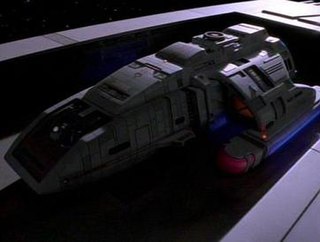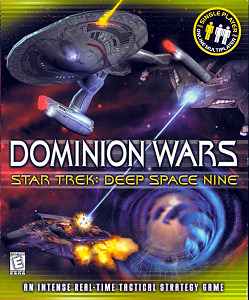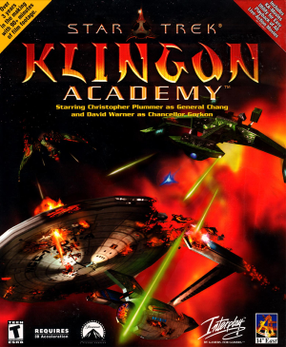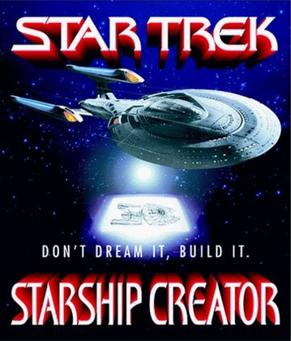Star Trek: Deep Space Nine (DS9) is an American science fiction television series created by Rick Berman and Michael Piller. The fourth series in the Star Trek media franchise, it originally aired in syndication from January 3, 1993, to June 2, 1999, spanning 176 episodes over seven seasons. Set in the 24th century, when Earth is part of a United Federation of Planets, its narrative is centered on the eponymous space station Deep Space Nine, located adjacent to a wormhole connecting Federation territory to the Gamma Quadrant on the far side of the Milky Way galaxy.
In the Star Trek science-fiction franchise, the Maquis are a 24th-century paramilitary organization-terrorist group. The group is introduced in the two-part episode "The Maquis" of the television series Star Trek: Deep Space Nine, building on a plot foundation introduced in the episode "Journey's End" of Star Trek: The Next Generation, and appear in later episodes of those two series as well as Star Trek: Voyager. The Maquis story debuted when three Star Trek television shows running from 1987 to 2001 took place in the same fictional science-fiction universe at the same time in the future. As a result, the Maquis story was told across several episodes in all three shows. The Maquis are especially prominent in Star Trek: Voyager, whose premise is that a Starfleet crew and a Maquis crew are stranded together on the opposite side of the Galaxy.
Starfleet is a fictional organization in the Star Trek media franchise. Within this fictional universe, Starfleet is a uniformed space force maintained by the United Federation of Planets as the principal means for conducting deep space exploration, research, defense, peacekeeping, and diplomacy. While most of Starfleet's members are human and it has been headquartered on Earth, hundreds of other species are also represented. Most of the franchise's protagonists are Starfleet commissioned officers.
The Star Trek fictional universe contains a variety of weapons, ranging from missiles to melee. The Star Trek franchise consists mainly of several multi-season television shows and a dozen movies, as well as various video games and inspired merchandise. Many aspects of the Star Trek universe impact modern popular culture, especially its fictitious terminology and the concept of weaponry on spacecraft. The franchise has had a widespread influence on its audiences from the late 20th to early 21st century. Notably, Star Trek's science fiction concepts have been studied by real scientists; NASA described it in relation to the real world as "entertaining combination of real science, imaginary science gathered from lots of earlier stories, and stuff the writers make up week-by-week to give each new episode novelty." For example, NASA noted that the Star Trek "phasers" were a fictional extrapolation of real-life lasers, and compared them to real-life microwave based weapons that have a stunning effect.
The Dominion War is an extended plot concept developed in several story arcs of Star Trek: Deep Space Nine, an American science-fiction television series produced by Paramount Pictures. In the fictional Star Trek universe, the Dominion War is a conflict between the forces of the Dominion, the Cardassian Union, and, eventually, the Breen Confederacy against the Alpha Quadrant alliance of the United Federation of Planets, the Klingon Empire and, later, the Romulan Star Empire. The war takes place in the final two seasons of the series, but is gradually built up to over the course of the five preceding seasons.

The USS Defiant is the name of two starships in the Star Trek media franchise, most notably featured in the television series Star Trek: Deep Space Nine (1993–1999) and the film Star Trek: First Contact (1996). Introduced in Deep Space Nine's third season, it is a warship attached to the show's eponymous space station. The original Defiant is destroyed during the Dominion War in the seventh season and replaced with a largely identical ship.

Runabouts are a fictional class of small, multi-purpose starships appearing in the Star Trek science-fiction franchise, primarily the television series Star Trek: Deep Space Nine, which aired on syndicated television between 1993 and 1999. They served as a means of transport for the crew of the fictional space station Deep Space Nine, in the early seasons of the series enabling storylines taking place away from the station.
This article discusses the fictional timeline of the Star Trek franchise. The franchise is primarily set in the future, ranging from the mid-22nd century to the late 24th century, with the third season of Star Trek: Discovery jumping forward to the 32nd century. However the franchise has also outlined a fictional future history of Earth prior to this, and, primarily through time travel plots, explored both past and further-future settings.

Enterprise (NX-01) is the fictional spaceship that serves as the primary setting of the American science fiction television series Star Trek: Enterprise. The ship predates the other Starfleet ships named Enterprise and was first seen in the pilot episode "Broken Bow". Its missions included an initial period of deep space exploration and a mission into the Delphic Expanse following the Xindi attack on Earth; it was also instrumental in the formation of the United Federation of Planets with the Vulcans, Andorians and Tellarites.

Star Trek: Deep Space Nine: Dominion Wars is a 2001 space combat/real-time tactics video game for Microsoft Windows developed by Gizmo Industries and published by Simon & Schuster. The game is based on the Star Trek TV show Star Trek: Deep Space Nine.
Star Trek fan productions are productions made by fans using elements of the Star Trek franchise. Paramount Pictures, CBS, and their licensees are the only organizations legally allowed to create commercial products with the Star Trek name and trademark. The fan film community has received some coverage from the mainstream media.

Star Trek: Klingon Academy is a space flight simulator video game developed by 14 Degrees East, an internal development house of publisher Interplay Entertainment. The game follows a young Klingon warrior named Torlek as he attends the Elite Command Academy, a war college created by General Chang to prepare warriors for a future conflict with the United Federation of Planets. Christopher Plummer and David Warner reprised their respective roles as Chang and Gorkon for the production of Klingon Academy.
"Valiant" is the 146th episode of the television series Star Trek: Deep Space Nine, the 22nd episode of the sixth season. It was first broadcast on television on May 4, 1998.

Star Trek: Encounters is a video game set in the Star Trek fictional universe, which was released in 2006 for the PlayStation 2. The game was developed by Scottish studio 4J Studios for Bethesda Softworks and Ubisoft (EU).

Star Trek: Starship Creator is a computer-based vehicle simulation game developed by Imergy and released by Simon & Schuster Interactive in 1998 for both Microsoft Windows and Mac OS, based on the official license of the Star Trek franchise. Elements in the game were created in conjunction with the technical advisers for the series and films, such as Mike and Denise Okuda. The gameplay in Starship Creator allowed for the player to equip and crew a series of different starship classes from across the Star Trek universe, including those from both the various series and the film series. An expanded version was subsequently released as Star Trek: Starship Creator Deluxe in late 1999 which added further starships, missions and customization. The official website also contained downloads for the characters from the Star Trek: New Frontier series of books. Reception by critics for Starship Creator was negative, with criticism directed at the gameplay and graphics, and the suggestion was made that the game would only appeal to Star Trek fans. A sequel followed in 2000 entitled Star Trek: Starship Creator Warp II.
The following outline is provided as an overview of and topical guide to Star Trek:







